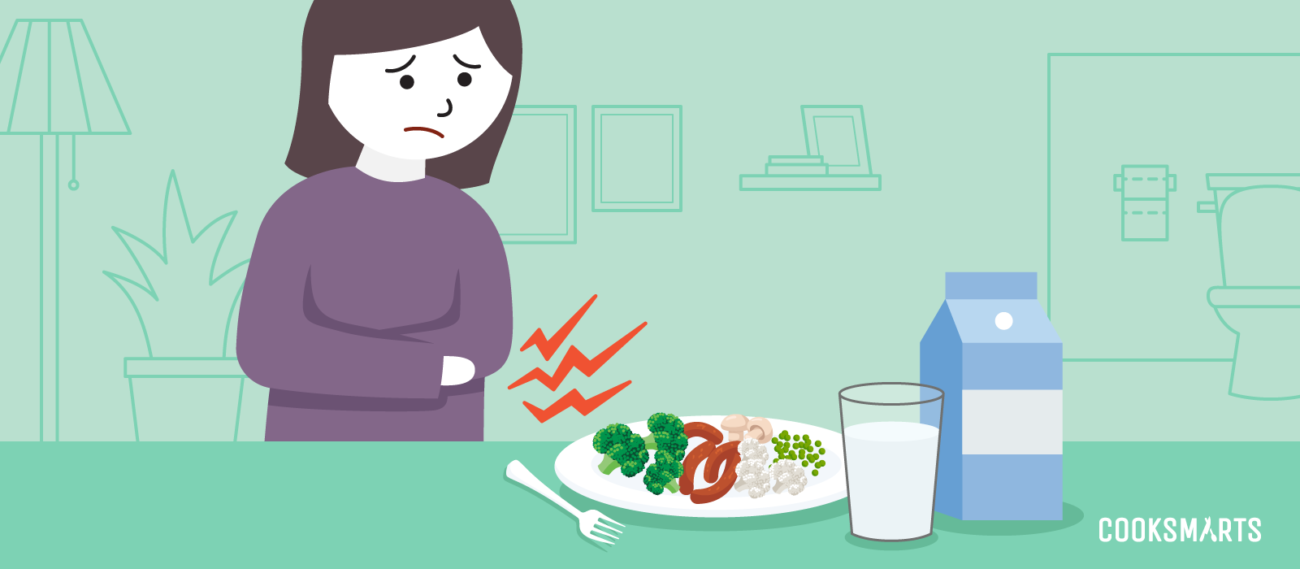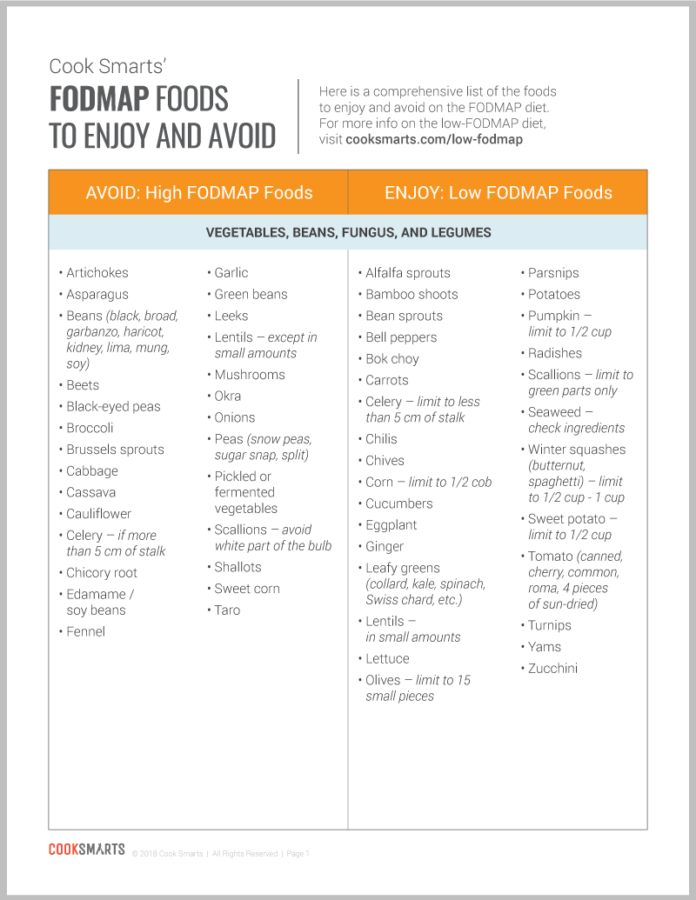How and Why to Start a Low-FODMAP Diet
A good FODMAP diet plan may be the answer to your digestive issues, and our guide is here to help!
It seems like everyone knows at least two people with digestive problems these days. Irritable bowel syndrome (IBS) and other gut issues plague millions of people in the U.S. alone, yet definitive causes and cures are often elusive.
Thankfully, a low-FODMAP diet has been seen to decrease symptoms in many who suffer with digestive disorders and unexplained abdominal pain. If stomach discomfort is a part of your daily life or the life of someone you love, read on to learn what you can do.

How a Low-FODMAP Diet Works
Learn more about the low-FODMAP diet and what foods to enjoy and avoid with our guide!
What is the Low-FODMAP Diet?
A low-FODMAP diet is a diet that restricts certain short-chain carbohydrates that don’t absorb well in the small intestine. FODMAP is an acronym that stands for “Fermentable Oligo-, Di-, Mono-saccharides And Polyols”. Now the sound of that probably makes you want to close this page right now. But, wait! We promise not to speak “science” anymore. We are here to translate everything into easily understandable pieces.
Here is what FODMAP includes:
F ermentable
Groups of food that bacteria in your colon will ferment are included below.
O ligosaccharides
This category includes two sub-groups:
- Fructans are large molecules in fructose, found in foods like wheat, onions, garlic, artichokes, asparagus, and agave.
- Galacto-oligosaccharides (GOS) are prebiotics, naturally occurring in numerous whole grains, beans, legumes, and vegetables (like brussel sprouts, celery, and broccoli).
D isaccharides
These are sugars formed by two simple sugars, most commonly found in lactose, table sugar, and maltose (malt sugar). These are found in ingredients like milk, yogurt, maltodextrin, and corn syrup.
M onosaccharides
These are the most simple sugars and include fructose (fruit sugar), glucose, and galactose. These are found in ingredients like honey, orange marmalade, hazelnuts, casein, and black-eyed peas. Glucose is also in any food that has “dextrose” on the ingredient list, which is common in packaged and processed foods.
A nd
P olyols
These are sugar alcohols like xylitol, sorbitol, maltitol, erythritol, mannitol, and isomalt. These can be found in products like sugarless chewing gum, dried apricots, and wasabi.
Why Do FODMAPs Cause Digestive Problems?
When FODMAP carbs don’t absorb in the small intestines, they will then travel to the colon and be fermented by bacteria. This results in gases being created that can cause bloating, distress, and every type of IBS symptom.
If the bacteria are continually able to feed off of FODMAPs, they can grow out of balance, resulting in a small intestinal bacterial overgrowth (SIBO). People suffering with SIBO experience additional symptoms like nausea, malnutrition, and malabsorption, which have ramifications on all body systems and lead to a myriad of unexplained health problems.
Who Should Try a Low-FODMAP Diet?
People with abdominal pain, bloating, indigestion, nausea, constipation, diarrhea, and / or gas often are helped by a low-FODMAP diet. Studies have shown that this special diet can have positive effects on those with digestive issues, IBS, functional gastrointestinal disorders (FGID), inflammatory bowel disease (IBD), SIBO, fibromyalgia, food-triggered health issues, and certain autoimmune conditions like rheumatoid arthritis, multiple sclerosis, or eczema. If you have any of these conditions, a low-FODMAP diet has the potential to help.
But, please remember that it is always paramount to go to your health care professionals first and foremost when experiencing symptoms! You can also ask your doctor about doing a hydrogen and methane breath test to see if these gases are being produced in your digestive tract.
How to Start a Low-FODMAP Diet?
Phase I:
For 3 to 6 weeks, eliminate all high-FODMAP foods (download the food list for free here).
After the initial elimination period, take inventory of how your body feels. If your symptoms have reduced but are still present or you have experienced no change, consider extending Phase I. If your symptoms have improved, decide whether to extend Phase I for thoroughness or proceed to Phase II.
Phase II:
Systematically start reintroducing high-FODMAP foods back into your diet, slowly and one group at a time. You should spend a minimum of 1 week on a group before moving on to another, but this could be extended based on your body’s reaction.
When you reintroduce foods from one of the O-D-M-A-P categories, choose a food that has no other high-FODMAP ingredients in it. For example, if you start with disaccharides, don’t try milk chocolate first (although we know it’s tempting!) because it has lactose and sweeteners in it. Instead, try drinking pure milk.
Although the impulse may be to eat a lot of the food you’ve been missing, start with small amounts to avoid severe reactions. If you experience few or no symptoms, you can wait a day or two and then try a different food from the same group and see how you tolerate it.
If you react to multiple foods from one category, go back to the strict elimination diet for 1 week before trying the next FODMAP group.
Always slowly increase the amount of reintroduced food. If you are continually able to tolerate foods from a specific category, you know you are not currently reactive to that group of foods.
How Long Do I Stay on a Low-FODMAP Diet?
The intention of the FODMAP elimination diet is to not to be a permanent diet, but rather to give you information on how your body handles each group of these fermentable foods. Everyone’s body is different, so find the balance that works for you while making sure that you are getting all of the nutrients you need.
Limiting ingredients that cause your body distress can be difficult at first, but in the end it is a way to empower you to have a happier, healthier life. Also, bodies change, so it is a good idea to continually go back to trying high-FODMAP foods periodically and see if you can tolerate something new.
Remember that no matter what you can’t have, there are so many delicious, fresh ingredients from which you can make hearty and scrumptious dinners every day!
5 Tips for a Successful FODMAP Trial
1. Be realistic with yourself
Food is an integral part of our daily lives. Therefore, trying a new and restricted diet will certainly have effects on your body and schedule. If your current diet is in stark contrast to the low-FODMAP diet, you will likely feel withdrawals if you don’t ease yourself in by eliminating strategic foods a couple weeks prior to starting the diet.
Cooking everything from scratch takes time, so make sure you leave ample room in your schedule. This may mean cutting out activities for a period of time or asking loved ones for help. It is a good idea to plan on eating in or bringing a sack lunch with you, especially in the first couple weeks.
2. Never find yourself without a low-FODMAP snack
Being “hangry” is a real thing, so try to make sure you have adequate food intake while eliminating every opportunity to cheat on your diet. Once you eat a food you are supposed to avoid, it can throw off your ability to tell how your body is reacting to the FODMAP diet.
3. Keep a journal
Writing down what you eat and when you experience symptoms is one of the most helpful practices to prioritize during your diet. It is key to see patterns and be able to track your reactions when you eat a high-FODMAP ingredient vs a food with multiple high-FODMAP ingredients. Food and symptom journals can be really helpful for health care professionals working with you as well.
4. Get a convenient app
Monash University created the amazing Monash Low FODMAP App that helps you manage a low-FODMAP diet. For only $7.99, this app lets you check products and ingredients against their easy FODMAP food guide and get recipe ideas.
5. Manage your expectations
Remember that FODMAPs may not be the answer to your symptoms. Everyone’s body is different, so it is possible to try this diet and feel no real impact on your health. Go into the diet with hope (many people experience a tremendously positive response!), but know that low-FODMAPs are not a cure-all.
FODMAP Foods to Enjoy & Avoid
We put together a comprehensive list of the dos and don’ts of FODMAP foods just for you! To make sure you have quality information, we combined several lists (including ones from leading universities like Stanford and Harvard) into this free downloadable FODMAP food list:

If you have tried a low-FODMAP diet before, tell us how it went and feel free to share any helpful tips you have in the comments below.
As always, we create content that will help you live your best and healthiest life in the kitchen. For more cooking know-how, sign up for our newsletter below, and we’ll help you raise your kitchen IQ and cook with confidence by sending you our best cooking tips, articles, and infographic guides.
